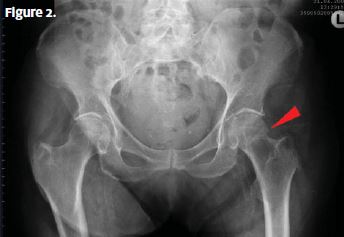Published on
 Differential Diagnosis
Differential Diagnosis
- Osteoporosis
- Inferior pubic rami fractures
- Intertrochanteric hip fracture
- Subcapital hip fracture
- Pathologic femur fracture
Physical Examination
On physical examination, the patient has a temperature of 98.8°F (37°C), a pulse of 112 beats/min, a respiration rate of 20 breaths/min, a blood pressure of 146/92 mm Hg, and an oxygen saturation of 99% on room air. She is alert and oriented and is not in acute distress. She has a regular heart rate and rhythm without murmur, rub, or gallop. Her abdomen has a normal appearance, has no surgical scars, and is soft and nontender without rigidity, rebound, or guarding.Palpation shows her pelvis to be stable, but she feels pain when her right hip is palpated, as well as pain on passive range of motion. She has no leg-length discrepancy.
Her medical history reveals that she has osteoporosis, hypertension, and acid reflux disease. She takes Fosamax (alendronate), hydrochlorothiazide, and omeprazole. She smokes cigarettes.
Diagnosis
An x-ray of the painful hip (Figure 2) is performed, and it shows a subcapital hip fracture (arrowhead).
Learnings
Fractures of the proximal femur account for 11.6% of all fractures in older adults (average age, 80.5 years) in the United States and occur in women three times as often as in men. Each year, more than 250,000 hip fractures occur, at a total annual cost of about $8 billion. Plain radiographs are 90% sensitive for detecting hip fracture. With a typical mechanism of injury (a fall onto a hip), typical symptoms (hip pain worse with movementthrough the range of motion), and typical examination findings (a shortened and externally rotated painful hip), the diagnosis is easy.
However, with an impacted, nondisplaced, or stress fracture, a patient may still be able to ambulate, and the fracture may not be evident on plain x-rays. Hip fractures in patients with osteoporosis may not be visually detectable.
Explore causes for the fall that might be rectifiable, including:
- Dementia
- Balance problems
- Difficulty with vision or hearing
- Alcohol or substance use
- Repeated falls
- Domestic abuse (elder abuse)
- Deconditioning
What to Look For
During the physical examination, check for the following:
- The patient’s general appearance, position, and ability to ambulate
- Location of pain
- Exacerbators of pain such as movement through the range of motion
- Shortening of the affected leg
- External rotation and abduction
- Swelling over the hip
- Skin changes such as ecchymosis
The following diagnostic tests are appropriate.
- X-rays (plain film): approximately 90% of fractures will be evident on plain x-rays
- Computed tomography scans: more sensitive than plain x-rays for detecting hip fractures
- Magnetic resonance imaging: more sensitive than computed tomography and bone scans
Transfer the patient to an emergency department in the presence of the following:
- Diagnosed hip fracture
- Suspicion for hip fracture despite normal x-ray findings
- Concern that there is multi-trauma such as a closed-head injury, cervical spine fracture, or thoracoabdominal trauma
- Hemodynamic instability
- Inability to adequately assess the patient because of severe pain, altered mental status, or body habitus
